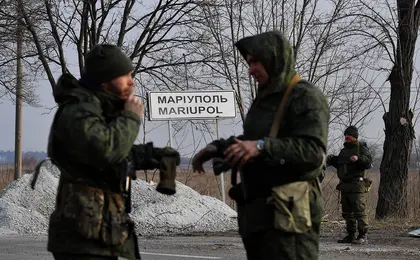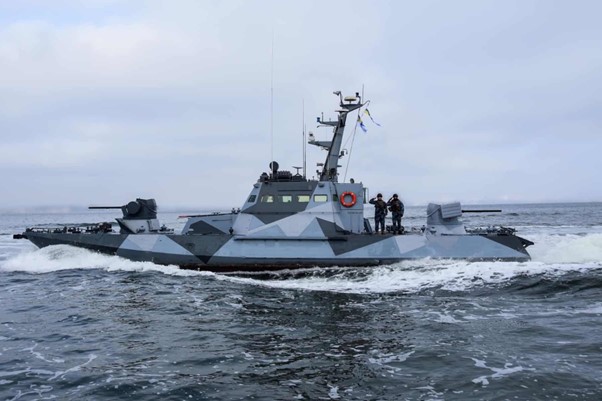A series of Armed Forces of Ukraine (AFU) strikes using an unidentified weapon hammered targets in Mariupol. The Russian-occupied Azov Sea port city is a key Russian army logistics center previously thought to be well outside the effective range of Ukrainian cannon and missiles, a senior Kyiv official said on Thursday.
Nataliya Humeniuk, senior spokeswoman for the AFU’s Joint Forces South, was cryptic in a Feb. 23 statement confirming the three day strike series, saying “At this stage, we can only state that inaccessibility is a very relative concept. What is considered so remote that it is unreachable, is not always so. The direction of Mariupol is no longer completely unreachable for us.”
- Access the newest Ukraine news items published today.
- Access the latest Ukraine news coverage for today.
JOIN US ON TELEGRAM
Follow our coverage of the war on the @Kyivpost_official.
Nighttime blasts in and around Mariupol airport on Feb. 21 and 22, and a series of daytime strikes on Feb. 23, were widely reported in Russian-controlled information platforms, independent Ukrainian news outlets, and local social media. Some, but not all, of the accounts alleged the AFU had employed a new, long-range weapon in the strikes.
Video and eyewitness accounts from Feb. 21 showed intense Russian army auto-cannon fire and multiple anti-aircraft missile launches against unidentified airborne targets in airspace above the city’s western Kalmius district. Some video also recorded ground explosions. Ukrainian official Telegram channels said at least 11 or 12 blasts hit Mariupol airport, and two or three explosions on the premises of a steel mill. Most reports said there were 15 total impacts.

Russia Inches Closer to Dnipropetrovsk, Bombings Intensify
Petro Andriushchenko, exiled mayor of Mariupol, in a public statement said the strikes set two major aviation fuel storage sites on fire at the airport, and badly damaged Russian troop quarters at the steel mill. The Ukrinform news agency confirmed the strike locations, and the UNIAN news agency reported a military aviation ammunition storage site had been blow up.
Eleven more Ukrainian weapons reportedly struck military targets in the Mariupol area on Feb. 22 during the nighttime hours, and three more explosions, one of which multiple sources confirmed in the vicinity of the seaport, were reported on Wednesday. Following the third strike, Russian air force Su-25 ground strike aircraft, apparently based at the airport and scrambling to get to safety in the air, were spotted flying over the city.
Humeniuk’s remarks were the first official confirmation that the AFU had, by some means, struck targets in Mariupol at a longer range than it had been able to in the past.
Russian military blogger Ivan Utenkov on Feb. 22 filed a report from Mariupol stating “some new munitions” were behind the blasts and that “I am shocked about yesterday’s attacks.” Other pro-Russia military-associated social media echoed Utenkov’s allegation, pointing to the Ukrainian strikes’ taking place well outside the known range of AFU-operated HIMARS and M270 systems.
The most common long-range strike weapons employed by the AFU in the war thus far, the US-made M270 and HIMARS multiple-launch rocket systems, have been in the field in Ukraine since late June. The Ukrainians have used them primarily to fire GPS-controlled precision-guided missiles (GMLRS) to hit high value targets like Russian ammunition depots or command headquarters.
The maximum range of the M31A1 missiles made available to the Ukrainians by Washington for the HIMARS and M270 systems is, according to news reports and official Ukrainian statements, about 70 kilometers, depending on firing conditions.
The U.S. has, despite repeated Ukrainian requests, refused to transfer to Kyiv an upgraded GMLRS missile with an advertised range of 150 kilometers. Some Washington officials have said giving Ukraine longer-range weapons might make the Kremlin aggressive.
The closest viable launch locations suitable for a Ukrainian guided missile strike using the HIMARS system, against Mariupol, are probably 80 to 85 kilometers away from where the explosions took place. The M31A1 manufacturer Lockheed-Martin gives the range of the M31A1, a weapon carrying an 88-kilogram warhead, at “exceeding 70 kilometers.”
Independent sources say the M31A1 weapon is among the world’s most accurate missiles, able to strike inside a 1.5 meter circle consistently at all ranges. Russia-associated information platforms agree on the missile’s high accuracy, but generally estimate its effective range at 80 to 85 kilometers.
Euan MacDonald, a senior editor at the Novoe Vremya news magazine, was one of many Ukrainian media to suggest that, in the wake of the Mariupol strikes, that another weapon besides the well-known HIMARS might have been employed.
“Ukraine shaping the battlefield ahead of a fresh offensive. But what was it that hit Mariupol last night, deep in enemy-held territory, beyond HIMARS range?,” MacDonald said in a Tuesday tweet. “Are GLSMBs in play, or was it Ukraine’s Vilkha-M heavy MLRS?”
Vilkha-M is a Ukrainian long-range rocket system in operation since 2008. The weapon has a range of 130 kilometers. According to the Kyiv-headquartered Luch design bureau, a Vilkha-M missile is unguided but will usually strike within a 30-meter circle at long ranges.
GLSMB (Ground-launched, Small Diameter Bomb) is a weapon under development by Sweden’s Saab and U.S. aerospace giant Boeing. In testing since the late 2010s, it is designed to extend the range of a missile usable by a HIMARS by fitting the GPS-guided warhead with glider wings, enabling the munition to fly to the target at ranges up to 150 kilometers and consistently hit a meter-wide target.
The U.S. and Sweden in early January announced plans to deliver GLSMB munitions to Ukraine. Saab tested the weapon successfully in 2019 but as of the end of 2022 it was not in production, news reports said.
You can also highlight the text and press Ctrl + Enter










